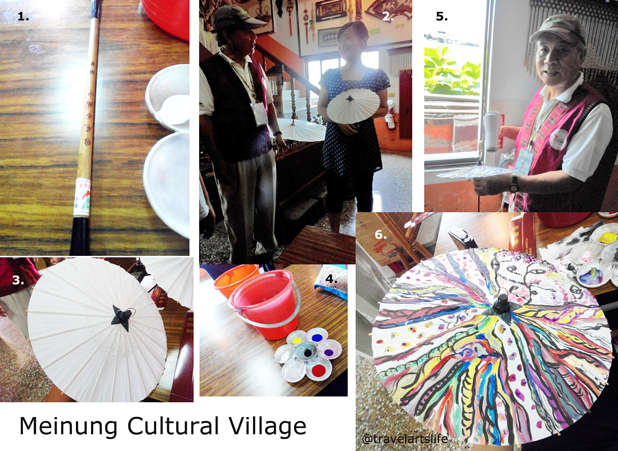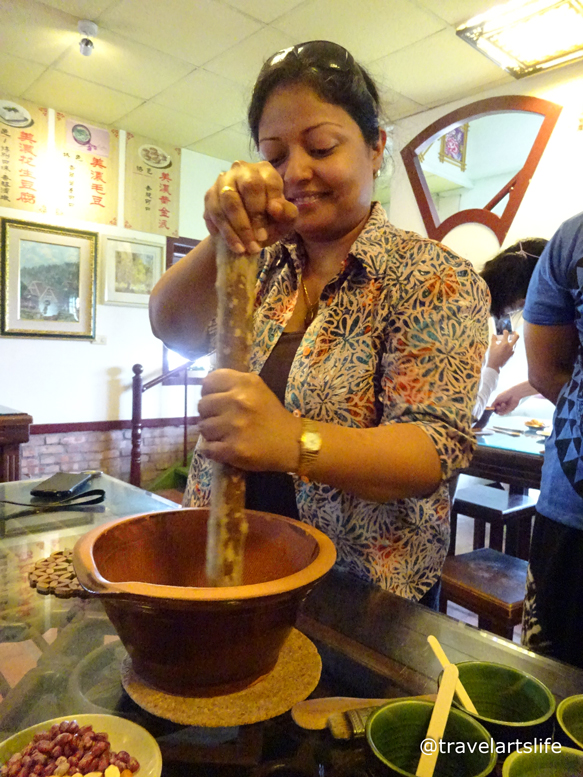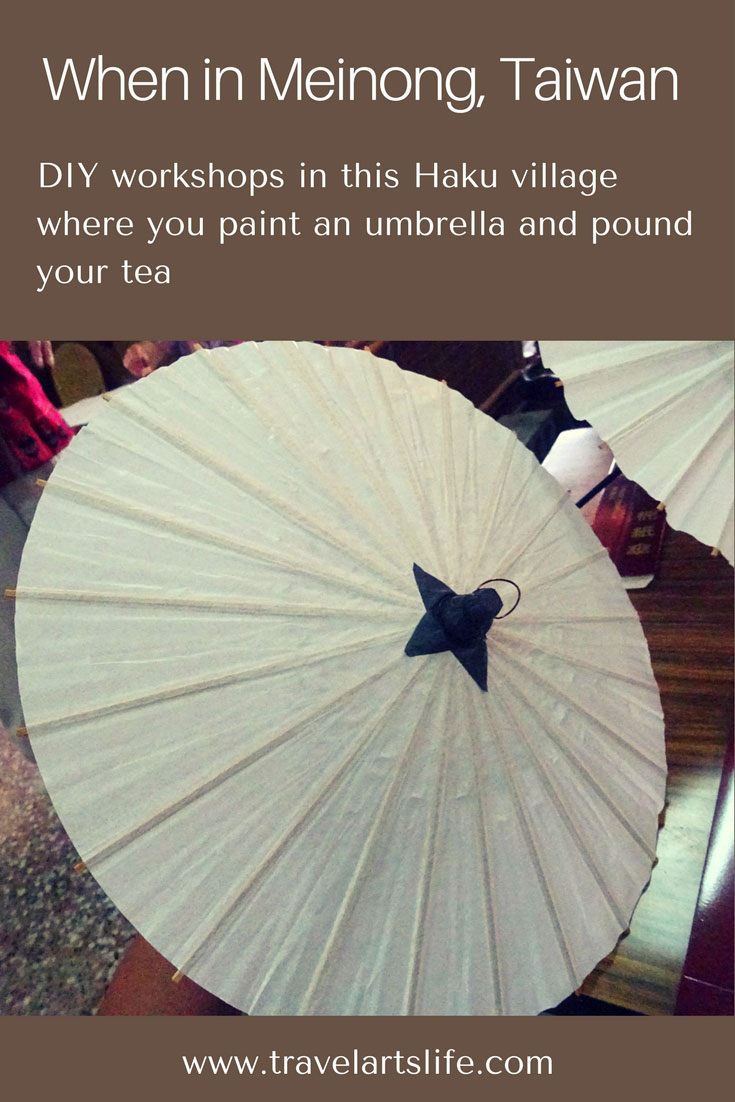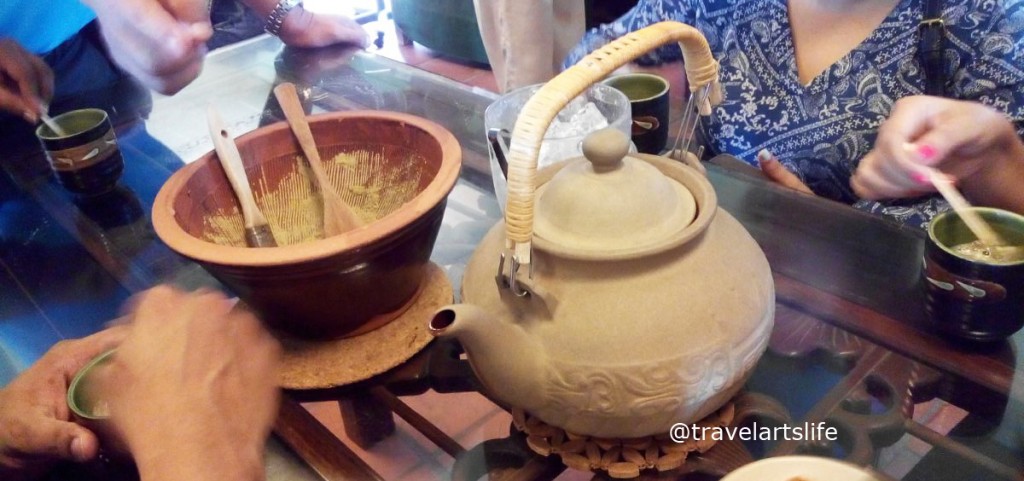Meinong, Kaoshiung, Taiwan:Â Tucked in the midst of nature, mountains, and virgin blue skies, the village is a symbol of culture and history taken seriously. If you are reading this, I am assuming you are an artist, a travelling artist and you love DIY and trying handcrafted techniques from different cultures. This is where, far from the madding crowd, that traditional culture still reigns.
For a bit of a historic background, Kaoshiung is the southwest of Taiwan, just above the Pingtung county and below the Tainan county (North) and Nantou county (North east) – both of which I visited. It is a former Dutch colony and evidence of this is seen throughout the city. Weather wise, I found Kaoshiung to be quite humid (it was the end of November), and hotter than Taipei (so keep this in mind if you decide to travel to Kaoshiung. I had a face spritzer that kept me cool).
The Meinong village is the focal point of pure Hakka culture. From the bit that I’ve read and heard, Hakka people make up the majority of the population in the Meinong township. Originally from China, they lived around the Yellow River (China’s second longest river) as the Han Chinese clan before migrating to Taiwan’s Kaoshiung county. If you want to know more about the representations of races in Taiwan, read more here.

In the Meinong Hakka cultural village. A room with a view. Wouldn’t you like to live in this quiet village, painting, crafting, drinking awesome tea?

Before we climb the stairs. Loving the intricate details of the pillars. I am in the courtyard, where a Hakka gentleman plays on a music instrument, while the central waterfall gently adds to the quiet and peaceful ambience.
Painting the umbrella
The elderly guide himself is Hakka but speaks in flawless English. “I was an English school teacher,” he starts to say, while he patiently dries my oil paper umbrella that I’ve painted on (yes, you may have gathered that I’ve said nothing about the actual process of painting, except that I found it to be so therapeutic and soul refreshing. If you want to know exactly how it’s done, read here and here). I learn more about the origins of the oil paper umbrella craft which is supposed to play an important role when a Hakka son or daughter get married. I then ask him about the Yellow River. You see, as a child, I learnt to sing the Yellow River and play it during school assembly (I led the school band in those days). Was is the same yellow river that the Hakka people migrated from? One will never know. All I know was that, we both sang to the tune of Yellow River while my pretty oil paper umbrella was drying.
While the area feels very touristy, there is a feeling of lived in feel.

DIY paint your own umbrella at Hakka Cultural Village. (1) the paintbrush with a thick ‘nib’ (2) The lady who demos us how to paint and is pretty good at rescuing umbrellas that didn’t turn out well, design wise (3) That’s my bamboo & oil-paper umbrella ready to be painted out. Can’t wait (4) My favourite tools – water and water colours (bit surprised that we can use water colours on the umbrella)Â (5) My guide dries my umbrella who, as someone said, ‘You used all the colours!!!” (6) My umbrella which caused a bit of a stir, because it didn’t make ‘sense’ or wasn’t ‘beautiful’ or eye-catching in any shape or form. For me, I intuitively drew my internal four seasons, which are demarcated really well. I did have an issue with the thick nib when it came to trying to delicately outline the designs. See more of my crazy artwork and concepts on my art-design webpage.

These are the smallest sized umbrellas. The umbrellas hold a special ‘family’ significance to the Hakka culture.
Pound your tea
As you can imagine, once I am done with the painting of my umbrella (now tucked safely in an oblong cardboard box and ready to carry back home), I am feeling really hungry and thirsty. I didn’t have to ask for anything because we were quickly led to this room, which looks like a cafeteria, except that it’s not. The room has a low ceiling and a long table greets us. A mortar and pestle on the table, plus a bowl of black and white sesame seeds, tea leaves, and peanuts. I’ve since read else where that you can add rice and other lentils into the mix.
To make this tea, you have to pound the ingredients, not crush it. Patience is key. The lady keeps gripping my right hand to push it deeper into this deep wood mortar that has curved engraved lines in its insides. After the seeds and nuts have achieved some sort of powder consistency, we add another powder which is green in colour (it looks like your favourite green tea powder) and is made of 27 different grains including millet already ground with green tea powder. An exact recipe can be found here. This tea is also called Thunder Tea, and once prepared, you add scoops of the powder into a cup and top it up with either hot or cold water. It’s up to you. I found it very much to drinking my green healthy drink first thing in the morning. Very nutritious I bet. It’s also made as a nutritious soup, something that I learnt here.

I may be smiling, but it’s no easy work pounding the roasted peanuts and sesame seeds, again and again.
The Meinong Hakka people are also known for their pottery, sadly, I have not had a chance to try my hand at this ancient craft. Neither was there time to admire the handmade polymer clay beads and jewelry, an artform that I use in my own art (read more here and here).

Rows of bottles heaped with pickled looking delicacies (lentils I think?), at the Hakka Cultural shop.
How to get to Meinung:
From Taipei City, take bullet train to Kaoshiung which should around an hour and a half. If you prefer a bus ride, then be prepared – it’s a long journey. You may decide to take the bus from Taipei through Nantou and Tainan down to Kaoshiung. Finally another bus ride to Meinung! (I’m trying to get hold of a map of where Meinung is located; a map that I can use here. Stay tuned).
Note:
While the trip to Taiwan was sponsored, all the content in this post is my opinion. The photos are also © travelartslife







What a wonderful place! Painting an umbrella would be a lot of fun.
oh how beautiful those umbrellas are gorgeous
come see us at http://shopannies.blogspot.com
Love all the pictures you got!
These photos are absolutely gorgeous! They remind me a lot of Hawaii!
I love exploring new cultures and things just different then I have experienced before. Great post!
Wow that looked like such a wonderful and full experience to cherish to years to come.
Wow, this was very interesting to read! Such beautiful photos. I love the umbrella painting.
Aww your photos are splendid, full of beautiful culture and history. Love your umbrella!
beautiful photos! Loved the umbrella painting
This experience sounds amazing. Thanks for sharing!
Very interesting post! This village looks like a great place to visit.
What a beautiful experience! Looks like a fantastic trip! I’ve never been there, but I’m definitely adding this to my must-visit list!
What a lovely read! You’ve got me itching to travel!
What a unique experience! Your umbrella is beautiful, I want to pound my own tea lol!
Pounding is harder than just crushing. We went on forever and my muscles started to hurt lol!
Beautiful photos. Omg I would love to do this one day. I’m so envious of you. xx
Wow, that looks like such an authentic way to explore a new culture and learn about it. I would love to paint my own umbrella!
Nina
aworldofdresses.com
I really do envy travel bloggers. This looks like a great trip! I would love to paint one of those umbrellas!
Wow, I love tea, and I would love to try doing this too, someday! These activities look amazing!
What a cultural experience! I’ll be sure to check out these activities when I’m in Meinong, Kaoshiung. I’ve only been to Taipei. But I know Taiwan has so much agricultural goodness and scenic landscapes that I’ve yet to explore.
Unbrella painting sounds absolutely delightful! I haven’t explored Asia as much as I’d like to – your post is another kick in the pants to get up and go!
I am in awe of this beautiful experience, great post I love your writing! xo
This looks like such a cool trip. There are fantastic places, and I love learning how to make things. Speaking of tea, I need some right now! You’ve inspired me.